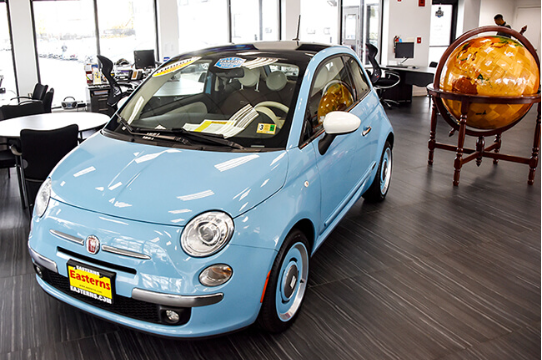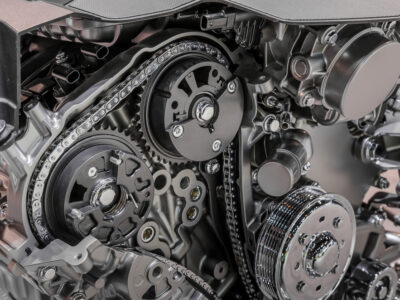
Fixing Loose Trim and Interior Rattles in Your Fiat 500

The Fiat 500 is a stylish and fun-to-drive city car, but like any vehicle, it can develop issues over time. One common problem owners face is loose trim and interior rattles, which can be annoying and detract from the overall driving experience. Fortunately, addressing these issues is often a straightforward process that can be done at home with basic tools. In this article, we'll explore the causes of loose trim and interior rattles in your Fiat 500 and provide step-by-step guides on how to fix them, helping you restore your car's interior to its original condition and enjoy a quieter, more comfortable ride.
Diagnosing and Repairing Loose Trim and Interior Rattles in Your Fiat 500
The Fiat 500 is a stylish and fun-to-drive car, but like any vehicle, it can develop issues over time. One common problem that owners may encounter is loose trim and interior rattles. These issues can be annoying and detract from the overall driving experience. In this section, we'll explore the causes of loose trim and interior rattles in your Fiat 500 and provide guidance on how to diagnose and repair them.
Identifying the Sources of Loose Trim and Rattles
To effectively fix loose trim and interior rattles, it's essential to identify their sources. Common areas where these issues occur include the dashboard, door panels, and rear parcel shelf. Inspect these areas carefully, looking for signs of wear, misalignment, or loose fasteners. Check for loose screws, clips, or adhesive failures that may be contributing to the problem. By pinpointing the source of the issue, you can develop a targeted repair plan.
Repairing Loose Trim and Interior Rattles
Once you've identified the sources of the loose trim and rattles, you can begin making repairs. This may involve reattaching loose trim pieces with screws or clips, or applying adhesive to secure loose components. In some cases, you may need to replace worn or damaged parts, such as weatherstripping or door panel clips. By addressing the root causes of the issue, you can eliminate the rattles and restore a smooth, quiet ride to your Fiat 500.
| Common Causes | Repair Solutions |
|---|---|
| Loose screws or clips | Tighten or replace screws/clips |
| Worn or damaged weatherstripping | Replace weatherstripping |
| Adhesive failures | Apply new adhesive or replace component |
Preventing Future Loose Trim and Rattles
To minimize the likelihood of loose trim and interior rattles developing in the future, it's essential to regularly inspect and maintain your Fiat 500's interior. Check for signs of wear and address any issues promptly. Additionally, avoid extreme temperatures and humidity levels, which can cause materials to expand and contract, leading to loose trim and rattles. By taking proactive steps, you can help ensure a quiet, comfortable driving experience for years to come.
What is the common problem with Fiat 500?

The Fiat 500 is a popular city car known for its stylish design and compact size. However, like any other vehicle, it has its share of common problems. One of the most significant issues with the Fiat 500 is related to its reliability and durability.
Transmission and Clutch Issues
The Fiat 500 has been known to experience transmission and clutch problems, particularly in the dual-clutch automated manual transmission models. This can cause issues with smooth shifting and may lead to premature wear on the clutch. Some common symptoms include:
You may be interested in reading How to Replace a Broken Door Handle on a Fiat 500
How to Replace a Broken Door Handle on a Fiat 500- Slipping or hesitation when shifting gears
- Grinding or clunking noises when engaging the clutch
- Failure to engage or disengage the clutch properly
Electrical System Faults
Electrical system faults are another common problem with the Fiat 500. This can manifest in a variety of ways, including issues with the infotainment system, navigation, and other electronic accessories. Some owners have reported problems with the car's electrical system causing erratic behavior or complete failure of certain components. Some examples include:
- Infotainment system freezing or crashing
- Faulty sensors or warning lights
- Intermittent or complete loss of certain electrical functions
Engine and Cooling System Problems
The Fiat 500's engine and cooling system can also be prone to issues. Some owners have reported problems with overheating, coolant leaks, and engine oil consumption. These issues can be caused by a variety of factors, including faulty thermostats, water pumps, or engine gaskets. Some common symptoms include:
- Overheating engine or coolant leaks
- Excessive engine oil consumption
- White smoke or coolant residue on the engine or ground
What are the worst years for the Fiat 500?

The Fiat 500 is a popular city car known for its stylish design and compact size. However, like any other vehicle, some model years have been plagued by issues and problems. The worst years for the Fiat 500 are generally considered to be the early 2010s models, particularly those produced between 2012 and 2014.
Reliability Issues
The early 2010s Fiat 500 models were marred by reliability issues, with many owners reporting problems with the car's electrical system, transmission, and engine. These issues were often caused by faulty software and hardware components, which led to a number of recalls and technical service bulletins. Some of the specific problems reported by owners include:
- Faulty electrical systems that caused issues with the car's infotainment system and other accessories
- Transmission problems, including slipping and hesitation
- Engine issues, such as oil leaks and faulty fuel injectors
Safety Concerns
Some model years of the Fiat 500 have also been criticized for their safety, with certain years being recalled due to concerns over the car's airbags, brakes, and other safety features. The 2012 and 2013 model years were particularly problematic, with a number of recalls issued due to issues with the car's airbag system. Some of the specific safety concerns reported by owners include:
- Faulty airbags that failed to deploy properly in the event of a crash
- Brake problems, including faulty brake calipers and brake fluid leaks
- Electrical issues that caused the car's safety features to malfunction
Common Problems
In addition to reliability and safety issues, some model years of the Fiat 500 have also been plagued by common problems, such as issues with the car's paint and trim. The 2012-2014 model years were particularly prone to these types of issues, with many owners reporting problems with the car's exterior finish and interior components. Some of the specific common problems reported by owners include:
- Paint issues, including peeling and fading
- Trim problems, including faulty door handles and loose trim pieces
- Interior issues, such as faulty climate control systems and loose or broken dashboard components
Why is my Fiat 500 making a ticking noise?

 How to Replace a Broken Door Handle on a Fiat 500
How to Replace a Broken Door Handle on a Fiat 500 Unclogging Blocked Drains to Prevent Water Leaks in a Fiat 500
Unclogging Blocked Drains to Prevent Water Leaks in a Fiat 500The ticking noise in your Fiat 500 can be caused by various factors, and it's essential to identify the root cause to address the issue effectively. One common reason for the ticking noise is related to the engine's valvetrain. The valvetrain consists of components like lifters, camshaft, and valves, which work together to facilitate the engine's operation. When these components wear out or become faulty, they can produce a ticking or tapping noise.
Possible Causes of Ticking Noise
The ticking noise in your Fiat 500 can be attributed to several possible causes. Some of the potential reasons include:
- Low oil pressure or dirty engine oil, which can cause the engine's components to wear out and produce noise
- Faulty or worn-out lifters, which can cause the ticking noise, especially when the engine is cold
- Worn or damaged camshaft or valves, which can also contribute to the ticking noise
Engine oil plays a crucial role in the smooth operation of your Fiat 500's engine. When the engine oil level is low or the oil is dirty, it can cause the engine's components to wear out and produce noise. Some of the engine oil-related issues that can cause the ticking noise include:
- Insufficient engine oil level, which can cause the engine's components to wear out and produce noise
- Dirty or degraded engine oil, which can lose its lubricating properties and cause the engine's components to wear out
- Incorrect engine oil viscosity, which can affect the engine's performance and cause noise
Diagnosing the Ticking Noise
To diagnose the ticking noise in your Fiat 500, it's essential to perform a thorough inspection of the engine and its components. Some of the steps involved in diagnosing the ticking noise include:
- Checking the engine oil level and condition to ensure it's at the recommended level and is clean
- Inspecting the valvetrain components, such as lifters, camshaft, and valves, for wear or damage
- Using specialized tools, such as a mechanic's stethoscope, to pinpoint the source of the ticking noise
Frequently Asked Questions
What are the common causes of loose trim and interior rattles in my Fiat 500?
Loose trim and interior rattles in your Fiat 500 are often caused by worn-out or damaged clips, screws, or fasteners. Over time, these parts can become loose due to vibrations, temperature changes, or wear and tear. Additionally, debris or dirt accumulation can also contribute to these issues. Inspecting the trim and interior components regularly can help identify the root cause.
How do I identify the source of the rattling noise in my Fiat 500?
To identify the source of the rattling noise, start by listening carefully to the sound while driving or gently shaking the suspected area. You can also use a mechanic's stethoscope or a long screwdriver to help locate the noise. Inspect the trim, dashboard, and other interior components for any signs of wear, damage, or looseness. Checking the owner's manual or online resources can also provide guidance on common problem areas.
Can I fix loose trim and interior rattles in my Fiat 500 myself?
Yes, many loose trim and interior rattles can be fixed DIY. Start by inspecting and tightening any loose screws or clips. You can also use trim repair kits or adhesive-backed foam to secure loose trim. For more complex issues, consider consulting online tutorials or repair manuals specific to your Fiat 500 model. If you're not comfortable with DIY repairs, consider consulting a professional mechanic or auto body shop.
Are loose trim and interior rattles a sign of a more serious issue with my Fiat 500?
In most cases, loose trim and interior rattles are cosmetic issues that don't affect the safety or performance of your Fiat 500. However, if the rattling noise is accompanied by other symptoms such as dashboard vibrations or unusual sounds, it may indicate a more serious issue. If you're concerned, it's always best to consult a professional mechanic to rule out any underlying problems.
You may be interested in reading How to Replace a Broken Door Handle on a Fiat 500
How to Replace a Broken Door Handle on a Fiat 500 Unclogging Blocked Drains to Prevent Water Leaks in a Fiat 500
Unclogging Blocked Drains to Prevent Water Leaks in a Fiat 500 Adjusting the Handbrake on a Fiat 500: Step-by-Step Guide
Adjusting the Handbrake on a Fiat 500: Step-by-Step Guide
If you want to know other articles similar to Fixing Loose Trim and Interior Rattles in Your Fiat 500 you can visit the category Maintenance.
Deja una respuesta






More content of your interest